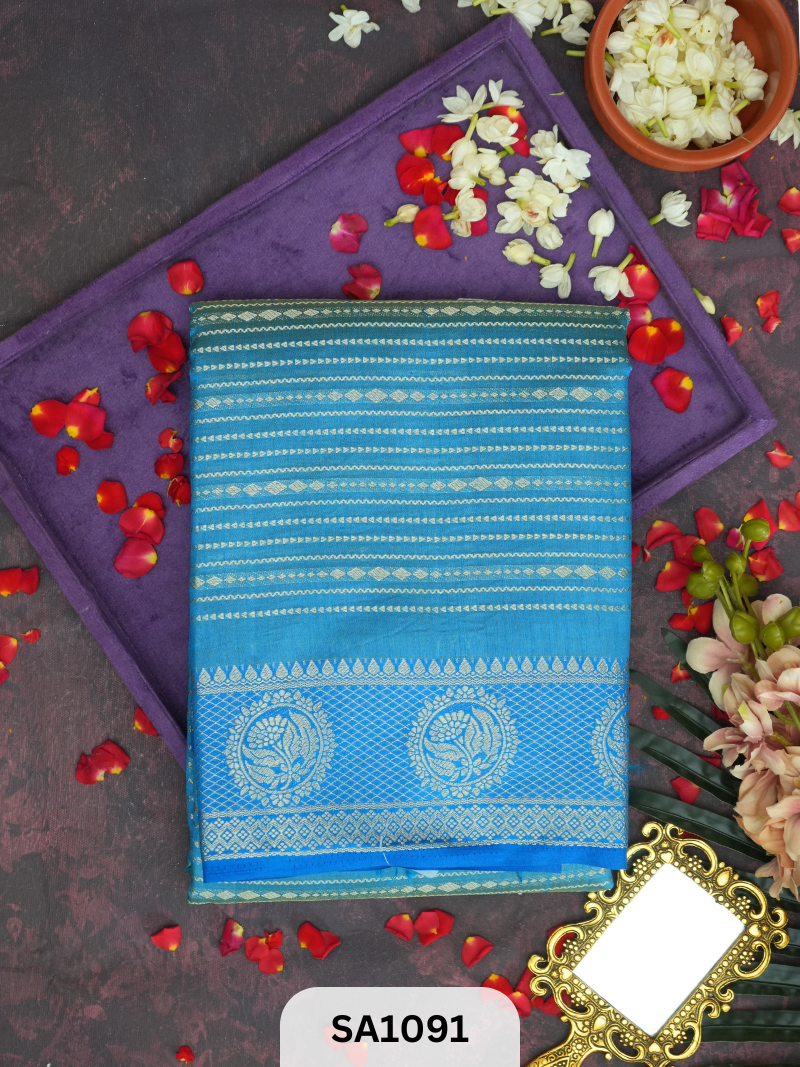SEMI DUPION TUSSAR
SEMI DUPION TUSSAR
SKU:SA1091
Couldn't load pickup availability
Description
Description
Semi Dupion Tussar Silk Saree – Where Heritage Meets Modern Elegance ✨
Handwoven by Master Artisans | Ethically Crafted | Perfect for Weddings, Festivals & Formal Occasions
- 🌿 Authentic Semi-Dupion Tussar Silk: Naturally textured, earthy luster, and breathable fabric — ideal for Indian summers and festive seasons.
- 🎨 Intricate Hand-Embroidered Borders & Pallu: Inspired by ancestral Kanchipuram and Bhagalpur weaving techniques, each motif tells a story of devotion and artistry.
- 👗 Lightweight Yet Luxurious Drape: Flatters every body type — perfect for saree drapes like Nivi, Bengali, or Gujarati styles.
- 🖋️ Designed by Shanmuga Priya & Azhagi: A fusion of traditional South Indian motifs with contemporary silhouettes — wearable heritage.
- 🌏 Eco-Friendly & Sustainable: Made from wild silk spun by Tussar moths — no chemicals, no exploitation, pure nature’s gift.
- 📦 Comes with Matching Blouse Fabric & Detachable Zari Border (optional upgrade available).
- 💎 Perfect For: Wedding guests, Deepavali, Pongal, Navratri, Eid, corporate events, and cultural performances.
- 🚚 Free Shipping Across India | International Shipping Available
2. A Legacy of Craftsmanship – The History Behind Semi-Dupion Tussar Silk
The tale of Semi-Dupion Tussar Silk begins in the dense forests of Jharkhand, Bihar, Odisha, and West Bengal — where wild silkworms (Antheraea mylitta) feed on Arjun and Asan leaves, producing silk that carries the soul of nature. Unlike cultivated mulberry silk, Tussar is wild, unbleached, and rich in golden-brown hues — a symbol of purity and earthiness in Indian textile history.
For centuries, tribal weavers in these regions have passed down the art of hand-spinning and hand-weaving Tussar silk using wooden looms. The “Semi-Dupion” variant — prized for its subtle irregularities and soft sheen — emerged as a refined choice among royalty and spiritual communities. It was worn by queens during temple processions and by brides seeking blessings under the sacred peepal tree.
Today, Shanmuga Priya & Azhagi revive this legacy. Our sarees are woven by 4th-generation artisans from Bhagalpur and Kanchipuram, who infuse each thread with reverence. We honor the tradition by preserving natural dyeing methods, avoiding synthetic finishes, and ensuring fair wages. This isn’t just a saree — it’s a living heirloom, stitched with stories older than empires.
3. Why Choose This? (The Unbeatable Edge)
✅ Genuine Handloom, Not Power-Loom – Every saree takes 7–15 days to weave. No machines. No shortcuts.
✅ Certified Organic & Fair Trade – Verified by Textile Export Promotion Council (TEPC) and Handloom Mark.
✅ Designed for Real Women – Light enough for all-day comfort, elegant enough for red carpets.
✅ Exclusive Designs by Shanmuga Priya & Azhagi – Limited edition prints you won’t find on Amazon or Myntra.
✅ Support Artisans, Not Corporates – With every purchase, you empower 8+ rural weaver families.
✅ Instagram-Worthy Aesthetic – #SareeStoryStyle has over 2.4M posts — wear what’s trending in luxury ethnic fashion.
✅ 100% Satisfaction Guaranteed – Free exchanges, lifetime repair advice, and personalized styling consultation.
FAQ
Q: What is the difference between Tussar and Banarasi silk?
A: Tussar silk is wild, naturally golden-brown, lightweight, and eco-friendly, while Banarasi is mulberry-based, heavily zari-laden, and heavier — perfect for winters. Tussar suits summer weddings; Banarasi for grand winter ceremonies.
Q: Is Tussar silk good for summer?
A: Yes! Semi-Dupion Tussar is naturally breathable, moisture-wicking, and cooler than cotton-silk blends — ideal for 30°C+ weather.
Q: Are Shanmuga Priya sarees worth the price?
A: Absolutely. You’re not paying for branding — you’re investing in 300+ hours of artisan labor, heritage design, and sustainable ethics. One saree = one family’s livelihood sustained for a year.
Q: Can I wear a Tussar saree to a wedding?
A: Yes — especially as a guest or bride. Semi-Dupion Tussar is now the top trend for pre-wedding mehndi, sangeet, and reception events in 2025 (per Vogue India & Harper’s Bazaar).
4. Wash Care Instructions – Preserve Your Heirloom
To keep your Semi-Dupion Tussar Silk Saree looking exquisite for decades:
💧 Wash Care Guide:
- ✅ Hand Shampoo Wash Only – Use mild, pH-neutral detergent (like Soak Wash or baby shampoo).
- ✅ Soak for 5–7 mins max – Gently swirl; never rub, twist, or scrub the zari or embroidery.
- ✅ Rinse in Cool Water – Avoid hot water to prevent color fading and fiber damage.
- 🌞 Dry in Shade Only – Never expose to direct sunlight — UV rays fade natural dyes and weaken silk fibers.
- 🧺 Iron on Low Heat – Use a cotton cloth between iron and saree. Steam gently if needed.
- 🧳 Store Flat or Folded – Wrap in cotton muslin, not plastic. Keep away from mothballs — use neem leaves instead.
- ❌ Do NOT Machine Wash, Dry Clean, or Bleach — These destroy the natural texture and zari integrity.
Let your customers fall in love — not just with a saree, but with a legacy.
Saree Story with Shanmuga Priya & Azhagi — Where every thread has a soul. 🌺
Material
Material
Refer product title
Shipping
Shipping
Free Shipping across India
Share


